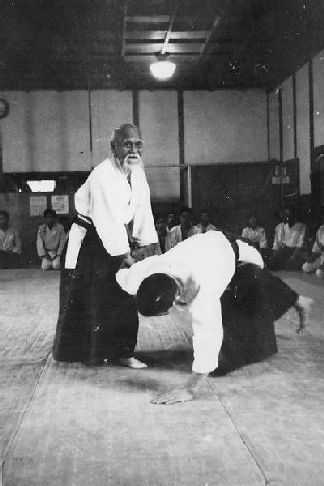|
|||
|
| -Countries |
| -Dictionary |
| -Federations |
| -M.A. Timeline |
| -Number System |
| -Styles |
| -Weapons |
| -Who's Who |
| -Updates |
| -Credits |
| -Stats |
| -Webmaster |
| Aikido
The basic skills of aikido come originated in Japan in about the 14th century. In the early 20th century they were systematized in their modern form through the work of the Japanese DaiToRyu Yawara (AiKi JuJitsu) expert Morei Ueshiba. There are no offensive moves in aikido. As taught by Ueshiba, it was so purely defensive an art that no direct contest between practitioners was possible. On the technical side, Aikido is rooted in several styles of jujitsu (from which modern judo is also derived), in particular daitoryu-(aiki)jujitsu, as well as sword and spear fighting arts. Oversimplifying somewhat, we may say that Aikido takes the joint locks and throws from jujitsu and combines them with the body movements of sword and spear fighting. However, we must also realize that many Aikido techniques are the result of Master Ueshiba's own innovation. On the religious side, Ueshiba was a devotee of one of Japan's so-called "new religions," Omotokyo. Omotokyo was (and is) part neo-shintoism, and part socio-political idealism. One goal of omotokyo has been the unification of all humanity in a single "heavenly kingdom on earth" where all religions would be united under the banner of omotokyo. It is impossible sufficiently to understand many of O Sensei's writings and sayings without keeping the influence of Omotokyo firmly in mind. Despite what many people think or claim, there is no unified philosophy of Aikido. What there is, instead, is a disorganized and only partially coherent collection of religious, ethical, and metaphysical beliefs which are only more or less shared by Aikidoists, and which are either transmitted by word of mouth or found in scattered publications about Aikido. Some examples: "Aikido is not a way to fight with or defeat enemies; it is a way to reconcile the world and make all human beings one family." "The essence of Aikido is the cultivation of ki [a vital force, internal power, mental/spiritual energy]." "The secret of Aikido is to become one with the universe." "Aikido is primarily a way to achieve physical and psychological self- mastery." "The body is the concrete unification of the physical and spiritual created by the universe." And so forth. At the core of almost all philosophical interpretations of Aikido, however, we may identify at least two fundamental threads: (1) A commitment to peaceful resolution of conflict whenever possible. (2) A commitment to self-improvement through Aikido training. Upon closer examination, practitioners will find from Aikido what they are looking for, whether it is applicable self-defense technique, spiritual enlightenment, physical health or peace of mind. O Sensei emphasized the moral and spiritual aspects of this art, placing great weight on the development of harmony and peace. "The Way of Harmony of the Spirit" is one way that "Aikido" may be translated into English. This is still true of Aikido today, although different styles emphasize the more spiritual aspects to greater or lesser degrees. Although the idea of a martial discipline striving for peace and harmony may seem paradoxical, it is the most basic tenet of the art.
THE FIVE PRINCIPLES OF AIKIDO as Taught by the Founder 1. Aikido is the path that joins all paths of the universe
throughout eternity; it is the Universal Mind that contains
all things and unifies all things.
|


 Aikido
is a Japanese martial art developed by
Aikido
is a Japanese martial art developed by